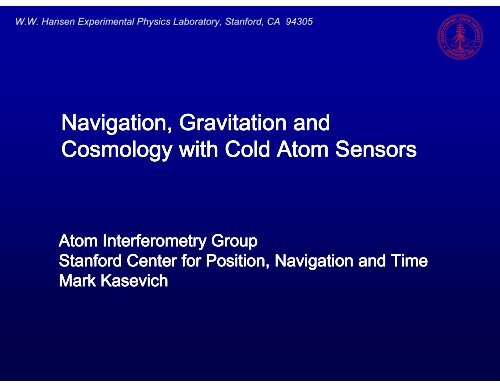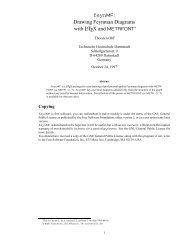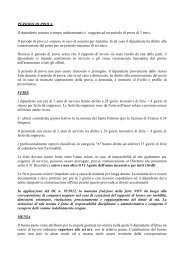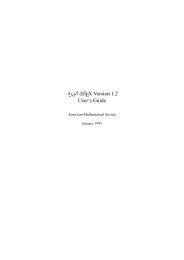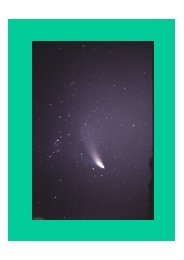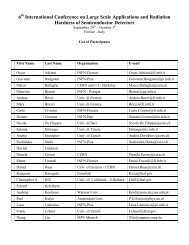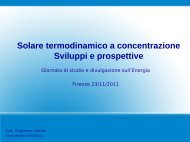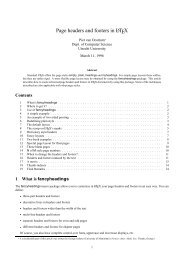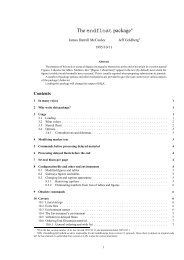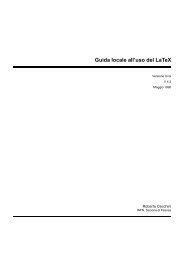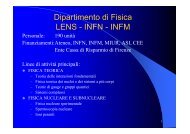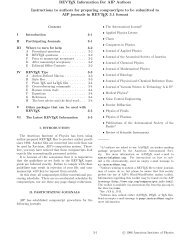Navigation, Gravitation and Cosmology with Cold Atom ... - INFN
Navigation, Gravitation and Cosmology with Cold Atom ... - INFN
Navigation, Gravitation and Cosmology with Cold Atom ... - INFN
You also want an ePaper? Increase the reach of your titles
YUMPU automatically turns print PDFs into web optimized ePapers that Google loves.
W.W. Hansen Experimental Physics Laboratory, Stanford, CA 94305<br />
<strong>Navigation</strong>, <strong>Navigation</strong>, <strong>Gravitation</strong> <strong>Gravitation</strong> <strong>and</strong><br />
<strong>and</strong><br />
<strong>Cosmology</strong> <strong>Cosmology</strong> <strong>Cosmology</strong> <strong>with</strong> <strong>with</strong> <strong>Cold</strong> <strong>Cold</strong> <strong>Atom</strong> <strong>Atom</strong> Sensors<br />
Sensors<br />
<strong>Atom</strong> <strong>Atom</strong> Interferometry<br />
Interferometry Group<br />
Group<br />
Stanford Stanford Stanford Center Center for for Position, Position, <strong>Navigation</strong> <strong>Navigation</strong> <strong>and</strong> <strong>and</strong> Time<br />
Time<br />
Mark Mark Kasevich<br />
Kasevich
de Broglie wave sensors<br />
Gravity/Accelerations<br />
As atom climbs gravitational potential,<br />
velocity decreases <strong>and</strong> wavelength<br />
increases<br />
g<br />
(longer de Broglie<br />
wavelength)<br />
Rotations<br />
Sagnac effect for de Broglie waves<br />
A<br />
GGI, 2006<br />
Current ground based experiments <strong>with</strong> atomic Cs:<br />
wavepacket spatial separation ~ 1 cm, phase shift resolution ~ 10 –5 rad
(Light-pulse) atom interferometry<br />
Resonant optical<br />
interaction<br />
|2〉<br />
|1〉<br />
2-level atom<br />
Resonant traveling<br />
wave optical<br />
excitation,<br />
(wavelength λ)<br />
Recoil diagram<br />
GGI, 2006<br />
Momentum conservation between<br />
atom <strong>and</strong> laser light field (recoil<br />
effects) leads to spatial separation<br />
of atomic wavepackets.
Enabling Science: Laser Cooling<br />
Laser cooling techniques are used<br />
to achieve the required velocity<br />
(wavelength) control for the atom<br />
source.<br />
Image source:www.nobel.se/physics<br />
Laser cooling:<br />
Laser light is<br />
used to cool<br />
atomic vapors to<br />
temperatures of<br />
~10 -6 deg K.<br />
GGI, 2006
Laboratory gyroscope<br />
AI gyroscope<br />
ARW 3 μdeg/hr 1/2<br />
Bias stability: < 60 μdeg/hr<br />
Scale factor: < 5 ppm<br />
(submitted for publication)<br />
ARW<br />
GGI, 2006<br />
Bias <strong>and</strong><br />
scale<br />
factor<br />
stability
Laboratory gravity gradiometer<br />
L a s e r B e a m<br />
<strong>Atom</strong>s<br />
<strong>Atom</strong>s<br />
Distinguish gravity induced<br />
accelerations from those due to<br />
platform motion <strong>with</strong> differential<br />
acceleration measurements.<br />
1.4 m<br />
σy(τ)<br />
10 -1<br />
10 -2<br />
10 -3<br />
10 2 10 3 10 4<br />
τ(s)<br />
GGI, 2006<br />
Demonstrated differential<br />
acceleration sensitivity:<br />
4x10 -9 g/Hz 1/2<br />
(2.8x10 -9 g/Hz 1/2 per<br />
accelerometer)
Gravity Gradiometer: Measurement of G<br />
Yale, 2002 (Fixler PhD thesis)<br />
Pb mass translated vertically along<br />
gradient measurement axis.<br />
GGI, 2006<br />
Status: δδδδG/G ~ 3 ppt (submitted for<br />
publication). See also Tino, MAGIA
Light-puse AI accelerometer<br />
characteristics<br />
• Bias stability:
<strong>Navigation</strong> performance<br />
Determine geo-located<br />
platform path.<br />
Necessarily involves geodetic<br />
inputs<br />
Simulated navigation solutions.<br />
5 m/hr system drift demonstrated.
Compact gravity gradiometer/gyroscope/accelerometer<br />
Multi-function sensor measures<br />
gravity gradient, rotation <strong>and</strong><br />
linear acceleration along a single<br />
input axis.<br />
Interior view<br />
Laser system
Control electronics frames<br />
(controls 6 sensor heads)<br />
Laser frames<br />
(scalable architecture<br />
provides light for 2-6<br />
sensor heads)<br />
Sensor electronic/laser subsystems<br />
DSP Master<br />
Sensor<br />
Master<br />
Amplifier<br />
Amplifier
Next generation integrated INS/GPS<br />
s a te llite n a v ig a tio n<br />
s ig n a ls<br />
`<br />
b e a m s te e r in g<br />
a n te n n a<br />
G e n e r a liz e d V e c t o r D e la y L o c k T r a c k in g N a v ig a t io n S y s t e m<br />
p a r a lle l c o r r e la to r<br />
b a n k<br />
`<br />
`<br />
c lo c k<br />
` `<br />
c h ip s c a le a to m ic<br />
c lo c k<br />
C o r d in a t e<br />
t r a n s la t o r<br />
`<br />
g e n e r a liz e d<br />
K a lm a n filte r<br />
`<br />
`<br />
K a lm a n<br />
F ilt e r<br />
In t e g r a t io n o f R F s a t e llit e , in e r t ia l, a n d c lo c k s e n s o r s in t o o n e<br />
q u a s i- o p t im a l N a v ig a t io n , A t t it u d e , T im e e s t im a t o r<br />
Stanford Center for Position, <strong>Navigation</strong> <strong>and</strong> Time.<br />
In collaboration <strong>with</strong> Per Enge, Jim Spilker<br />
IM U<br />
a to m ic in e r tia l<br />
m e a s u r e m e n t<br />
u n its<br />
<strong>Atom</strong>ic physics<br />
contributions<br />
GGI, 2006
Space-based applications<br />
• Platform jitter suppression<br />
– High resolution line-of-sight imaging from space<br />
– Inertial stabilization for next-generation telescopes<br />
• Satellite drag force compensation at the 10 -10 g accuracy level<br />
– GPS satellite drag compensation<br />
– Pioneer-type experiment<br />
• Autonomous vehicle navigation, formation flying<br />
Existing technology:<br />
- ESGN (submarine navigation)<br />
- Draper LN-TGG gyro<br />
- Litton/Northrop HRG<br />
(Hemispherical Resonator)<br />
LN-TGG; 1 nrad 0.1-100 Hz<br />
source: SPIE 4632-15<br />
Fibersense/NG<br />
IFOG
Accelerometers<br />
Earth<br />
Space-based geodesy (also lunar geodesy)<br />
100 m – 100 km<br />
300 km<br />
Accelerometer sensitivity: 10 -13 g/Hz 1/2<br />
− Long free-fall times in orbit<br />
Measurement baseline<br />
− 100 m (Space station)<br />
− 100 km (Satellite constellation)<br />
Sensitivity:<br />
− 10 -4 E/Hz 1/2 (Space Station)<br />
− 10 -7 E/Hz 1/2 (Satellite constellation)<br />
Earthquake prediction; Water table<br />
monitoring<br />
GOCE mission, 4x10 -3 E<br />
http://www.esa.int/export/esaLP/goce.html
Co-falling 85 Rb <strong>and</strong> 87 Rb ensembles<br />
Equivalence Principle<br />
Evaporatively cool to < 1 μK to<br />
enforce tight control over kinematic<br />
degrees of freedom<br />
Statistical sensitivity<br />
δg ~ 10 -15 <strong>with</strong> 1 month data<br />
collection<br />
Systematic uncertainty<br />
δg ~ 10 -16 limited by magnetic field<br />
inhomogeneities <strong>and</strong> gravity<br />
anomalies.<br />
Also, new tests of General Relativity<br />
Precursor to possible space-based<br />
system.<br />
10 m<br />
10 m atom drop tower.<br />
~10 cm wavepacket<br />
separation (!)
Use st<strong>and</strong>ard methods to<br />
analyze spurious phase shifts<br />
from uncontrolled:<br />
• Rotations<br />
• Gravity<br />
anomalies/gradients<br />
• Magnetic fields<br />
• Proof-mass overlap<br />
• Misalignments<br />
• Finite pulse effects<br />
Known systematic effects<br />
appear controllable at the δg ~<br />
10 -16 level.<br />
[δG/G ~ 10 -5 is feasible (limited<br />
by test mass)]<br />
Error Model
Equivalence Principle Installation<br />
<strong>Atom</strong>ic source<br />
10 m atom drop tower.
Light-pulse interferometer<br />
phase shifts for<br />
Schwarzchild metric:<br />
• Geodesic propagation<br />
for atoms <strong>and</strong> light.<br />
• Path integral<br />
formulation to obtain<br />
quantum phases.<br />
• <strong>Atom</strong>-field interaction<br />
at intersection of laser<br />
<strong>and</strong> atom geodesics.<br />
<strong>Gravitation</strong><br />
Objective:<br />
Ground-based precision<br />
tests of post-Newtonian<br />
gravity.<br />
Post-Newtonian trajectories for classical<br />
particle:<br />
From Weinberg, Eq. 9.2.1<br />
Prior work, de Broglie interferometry: Post-Newtonian effects of gravity on quantum<br />
interferometry, Shigeru Wajima, Masumi Kasai, Toshifumi Futamase, Phys. Rev. D, 55,<br />
1997; Bordé, et al.
Ground-based Post-Newtonian Interferometry<br />
Calculated phase shifts for ground<br />
based, 10 m, apparatus.<br />
• Analysis indicates that several<br />
post-Newtonian terms are<br />
comfortably <strong>with</strong>in apparatus<br />
reach.<br />
• In-line, accelerometer,<br />
configuration (milliarcsec link to<br />
external frame NOT req’d).<br />
• New constraints of PPN<br />
parameters.<br />
• Identification of most-promising<br />
space-based tests.<br />
Collaborators: Savas Dimopoulos,<br />
Peter Graham, Jason Hogan.
<strong>Cosmology</strong><br />
Are there (local) observable phase shifts of cosmological<br />
origin?<br />
Analysis has been limited to simple metrics:<br />
– FRW: ds 2 = dt 2 – a(t) 2 (dx 2 +dy 2 +dz 2 )<br />
– McVittie: ~Schwarzchild + FRW<br />
Work in progress …<br />
Future theory: Consider phenomenology of<br />
exotic/speculative theories (after validating<br />
methodology)<br />
Giulini, gr-qc/0602098<br />
Collaborators: Savas Dimopoulos,<br />
Peter Graham, Jason Hogan.<br />
From MTW
Future technology: Quantum Metrology<br />
<strong>Atom</strong> shot-noise limits sensor performance.<br />
Recently evolving ideas in quantum information science have<br />
provided a road-map to exploit exotic quantum states to significantly<br />
enhance sensor performance.<br />
– Sensor noise scales as 1/N where N is the number of particles<br />
– “Heisenberg” limit<br />
– Shot-noise ~ 1/N 1/2 limits existing sensors<br />
Challenges:<br />
– Demonstrate basic methods in laboratory<br />
– Begin to address engineering tasks for realistic sensors<br />
Impact of successful implementation for practical position/time<br />
sensors could be substantial.<br />
Enables crucial trades for sensitivity, size <strong>and</strong> b<strong>and</strong>width.
• Exploit exotic quantum<br />
states to measure phase<br />
shifts at Heisenberg (1/N)<br />
limit<br />
• CQED approach promising<br />
for precision sensors.<br />
Dispersive atom-cavity<br />
shifts enable requisite QND<br />
state preparation.<br />
• Possible 10x to 100x<br />
improvement in sensor<br />
noise.<br />
J Z<br />
J x<br />
J y<br />
Spin squeezed state<br />
enables 1/N sensitivity<br />
Quantum Metrology<br />
Possible QND detection of atom<br />
number (~5 atom resolution).
• Precision navigation<br />
– Pioneer<br />
• Equivalence Principle<br />
• Post-Newtonian gravity<br />
• <strong>Cosmology</strong><br />
Summary<br />
• + quantum metrology in future sensor generations
Thanks<br />
– Todd Gustavson, Research Scientist<br />
– Boris Dubetsky, Research Scientist<br />
– Todd Kawakami, Post-doctoral fellow<br />
– Romain Long, Post-doctoral fellow<br />
– Olaf M<strong>and</strong>el, Post-doctoral fellow<br />
– Peter Hommelhoff, Post-doctoral fellow<br />
– Ari Tuchman, Research scientist<br />
– Catherine Kealhoffer, Graduate student, Physics<br />
– Wei Li, Graduate student, Physics<br />
– Hui-Chun Chen, Graduate student, Applied Physics<br />
– Ruquan Wang, Graduate student, Physics<br />
– Mingchang Liu, Graduate student, Physics<br />
– Ken Takase, Graduate student, Physics<br />
– Grant Biedermann, Graduate student, Physics<br />
– Xinan Wu, Graduate student, Applied physics<br />
– Jongmin Lee, Graduate student, Electrical engineering<br />
– Chetan Mahadeswaraswamy, Graduate student, Mechanical engineering<br />
– David Johnson, Graduate student, Aero/Astro engineering<br />
– Geert Vrijsen, Graduate student, Applied physics<br />
– Jason Hogan, Graduate student, Physics<br />
– Nick Ciczek, Graduate student, Applied Physics<br />
– Mike Minar, Graduate student, Applied Physics<br />
– Sean Roy, Graduate student, Physics<br />
– Larry Novak, Senior assembly technician<br />
– Paul Bayer, Optomechanical engineer


